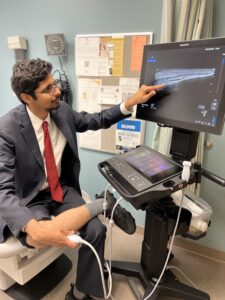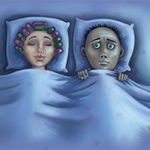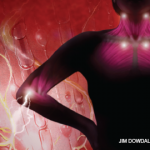It was like a reverse Uno card had been thrown onto the table. My patient was now asking his rheumatologist, “Are you okay? You look like you’re in a lot of pain.”
He was right. I was wincing trying to get up from my seat and limping trying to get a few steps over to the examination table. Stranger still, I didn’t have any pain or stiffness when I had sat down to begin the encounter only 30 minutes before. And while I was still functional during the visit, as the Friday afternoon clinic day went on, I became progressively more uncomfortable, to the point of needing a medical student to wheel me over in my chair from the patient’s room to the staffing area.
In retrospect, it’s kind of a funny role reversal, but in the moment, it was anything but. It was alarming, frightening and embarrassing—all at the same time. I was angry at my body and my immune system for not behaving like they should. Yet I was still lucky because I knew it was a flare of reactive arthritis. In fact, it was not even the first time that I had such a sudden lurch into acute inflammatory arthritis, so I did not panic. In fact, at every flare, I lean into it to better understand many of the life experiences of my patients.
Most of the time in this space, I rheuminate as a rheumatologist. Today, to commemorate Rheumatic Disease Awareness Month (RDAM), let me speak to you as a patient instead. So let’s rheuminate!
An Open Secret
One of my earliest memories is of my father falling on the floor, clutching his swollen and painful knee. He had called out to my mother to help him get up. Meanwhile, my older sister helpfully took me to the other room so I wouldn’t have to see this distressing sight. It was a flare of a mysterious condition that he has had since he was in his 20s. At the time, I had no idea what this was. I simply didn’t have the capacity to understand it, and I thought, maybe, this was something that everyone had once in a while. The fact that we didn’t even talk about it made it seem like a secret that was not worth exploring further.
Every few years, when we visited our extended family in India, I would see hints of a familial trait. There were many young uncles and aunties with stiff backs and difficulties getting up from seated positions. Sometimes, I would see them casually massaging their knees and ankles under the warm Indian sun. It wasn’t something that was obtrusive, but just odd enough that a kid would remember it. Certainly, if it was a secret, it was a fairly open one.
When I entered my third year of medical school, the pieces started to come together. Even with both of my parents being doctors, we didn’t really broach the topic until I mentioned that I was learning about ankylosing spondylitis. I was surprised to hear from my father that his maternal uncle (whom I had never met) had very classic ankylosing spondylitis. More stories came out about how my father struggled during medical school with swollen joints and even bouts of uveitis. He even disclosed that he had been prescribed large doses of salsalate, whose side effects were worse than its benefits. It was interesting to hear because he spoke about it in such a matter-off-act way. The only emotion that really came out was toward the end, when he sighed and said, “I hope it doesn’t affect you.”
As I reflect on this now, as a rheumatologist who routinely sees patients with inflammatory arthritis, I see strands that unite us. The idea of the arthritis being both a secret and yet self-evident, a badge of shared identity stemming from a source of dread and a certainty always shrouded in doubt, is something I think about every day, both as a patient and as a rheumatologist.
Becoming a Patient
Fast forward a few years and my family history became my fate. I had my first bout of inflammatory back pain during my intern year in residency at the University of Kentucky, Lexington. And like the most recent incident I already described, it happened so quickly I didn’t have a chance to even realize what was happening. Our team was rounding, and from room to room, I became more fidgety, trying to move around to stave off the stiffness. This behavior notably irritated my senior resident, who asked me if I was “tweaking.”
At the end of the day, it dawned on me what was occurring, and I took an ibuprofen to obtain some modicum of relief. In fact, I took NSAIDs for weeks on end, hoping it would just go away. The only reason I stopped was because I let it slip to my nephrology attending—and he admonished me against long-term NSAID use. Luckily, the pain did go away, and I didn’t need to worry about it, in large part because I had a lot of other things to worry about.
I was supposed to have an appointment with a primary care physician to discuss this—probably do some tests and X-rays and such. But the family history of having inflammatory arthritis wasn’t the only thing that ran in my family. I kept postponing my clinic visit during a very busy residency period. In the few times I had what appeared to be flares, I called the clinic for an appointment, only for the clinic date to be so far away that it never seemed to matter. I continued with my ibuprofen as needed.
While this story is certainly my own, it’s also the type of story that I hear often from my patients. I recognize the temptation of denial and delay. The first step of diagnosis is self-awareness, so it’s a cruel irony that patients, even physicians as patients, often don’t have the information necessary to become aware of the problem. Moreover, even with the understanding of the severe consequences of untreated autoimmune rheumatologic disease, it’s somewhat overwhelming to make a decision, and it sounds a little easier to just delay and hope for the best.
Being Both Patient & Doctor
There is admittedly a lot to unpack here. As rheumatologists, we often think about our rheumatic diseases as sources of physical pain. But during these episodes, I’ve found that the joint pain is only a small part of the larger pain that comes with rheumatic disease. Our entire mindset and worldviews change, as if a veil drops in front of your eyes. A condition that is chronic, as well as relapsing and remitting, comes with its own set of peculiarities.
The first thing that I—as a rheumatology patient—would like every rheumatologist to know is how much autoimmune rheumatologic disease affects our sleep and, as a result, diminishes our energy levels. During flares, the pain and stiffness, especially in my back, interfered with sleep. It didn’t stop me from falling asleep, but with every toss and turn in the early mornings, I was jolted awake by the pain. Trying to get back to sleep is a challenge, especially while trying to get into a position that keeps me comfortable for longer periods of time. And, of course, this has downstream ramifications. During flares, I wake up slightly earlier, not only because of the pain and stiffness interfering with sleep, but also because it takes longer to become functional during the morning with such prolonged morning stiffness. This lack of nighttime sleep means that I have to have a midafternoon nap to keep productive through the day. It’s not just the quantity of sleep that affected me. During flares, the lack of quality sleep means that I am foggier and have to rearrange my life to ensure that I can retain my focus. When I do sleep, nightmares are not unusual, likely due to the pain and the inflammation.
Just as important is the sense of guilt that accompanies rheumatic disease. A few years ago, I ate some Jif peanut butter contaminated with salmonella. A week later, I had to miss an advocacy conference in Washington, D.C., one of the great highlights of the year for me. I couldn’t help but feel guilty—I should have known better than to risk my health. Of course, it’s a misplaced sense of guilt, but one that hit deep nonetheless. Even with the advanced knowledge that has come through my training, I still feel as if there is some bad karma that has resulted in my weakness. When a flare comes on, my mind immediately drifts to “if only I had done this, or if only I had done that.” It makes me wonder whether I deserve what I have. What I wouldn’t give to rid myself of this burden. In those moments, I have to step back and reflect on the fact that is a matter of the balance of my cytokines, not the balance of my soul.
Finally, there is the sense of dread. I am fortunate that these flares last only a few weeks at a time. But what will happen in the future when osteoarthritis kicks in and this sort of pain and disability becomes a part of everyday life? Will the inflammation that defines my body be the source of its own demise—in the form of accelerated cardiovascular disease? I recently had my blood pressure taken and found out that I am prehypertensive. Although that may not seem like an issue, it left me crestfallen, fearing an inevitable decline. When I was being wheeled by my medical student in clinic that Friday afternoon, was that a foretaste of my future 20 years from now?
We are fortunate to live in an age of accelerating discovery when such outcomes are not preordained. That’s particularly important to me because I now have young children, and just like my father, I wonder if our family history will one day become their fate.
How Many More RDAMs?
As a rheumatologist, I recognize that we only have 30–60 minutes to talk with patients at a given time. Many practices allot even less, to maximize revenue and increase access. My experiences as both a patient with a rheumatic disease and as a rheumatologist privileged to treat those with rheumatic disease reminds me of how valuable every moment is in these interactions. We can only scratch the surface of what illness means and how pervasive the effects of rheumatologic disease are on the life of individuals and their families.
September is Rheumatic Disease Awareness Month. A month is not enough to encompass all the nuances of the scores of rheumatic diseases. My hope, as both a rheumatologist and as a patient, is that many RDAMs from now, we’ll look back at how quaint it was that we had to worry about such conditions. And, just as importantly, we’ll look back with immense gratitude at the hard work being performed by everyone in this sphere committed to ensuring that such diseases are consigned to the history books.
 Bharat Kumar, MD, MME, FACP, FAAAAI, RhMSUS, is the director of the rheumatology fellowship training program at the University of Iowa, Iowa City, and the physician editor of The Rheumatologist. Follow him on X (formerly Twitter) @BharatKumarMD.
Bharat Kumar, MD, MME, FACP, FAAAAI, RhMSUS, is the director of the rheumatology fellowship training program at the University of Iowa, Iowa City, and the physician editor of The Rheumatologist. Follow him on X (formerly Twitter) @BharatKumarMD.




